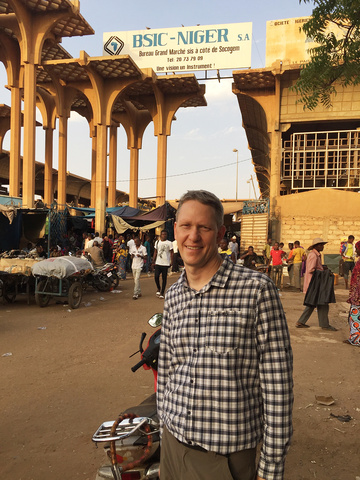
‘There is a sense that diagnosing with the hands and ears is a lost art’ — Hans House, MD
When Hans House, MD, took a two-week medical trip to Niger in February 2017 he measured his success in two ways: He taught local physicians in Niger how to use an ultrasound, and he rediscovered his appreciation for the level of care Americans take for granted.
House, an emergency medicine physician, went to Niambey, the capital of Niger, to advise providers in a primary care clinic and to teach trauma care. He taught the use of ultrasound at the bedside as well as classes on trauma and cardiac life support.
“I enjoy bringing my medical expertise to communities that are underserved,” House says, “and instructing the local physicians with medical advances that they can apply in a practical manner—such as ultrasound—is very rewarding. Furthermore, I am intellectually stimulated by treating tropical diseases that I don’t otherwise see in the United States.
“But the most significant reason for volunteering in resource-poor environments is to appreciate the level of care we have in the United States and push myself to be less reliant on imaging studies and laboratory tests,” House says. “I teach medical students physical examination techniques, and there is a sense that diagnosing with the hands and ears is a lost art. But when I am faced with treating a patient with diabetic ketoacidosis, and I only have a finger-stick glucometer, the creativity and medical ingenuity that had been previously repressed comes back to life and fills me with a renewed sense of purpose.”
House says he also discovered a renewed interest in using ultrasound at the bedside by teaching local doctors how to use an ultrasound they had never used.
“Prior to my trip to Niger I had scoffed at the idea of using ultrasound in developing countries,” he says. “Since ‘point-of-care’ ultrasound is a rapidly developing, new field of medicine in the United States, I had mistakenly assumed it was too new and advanced for resource-poor environments. I discovered, in fact, quite the opposite.”
Instead, he says, since ultrasound equipment often is portable, durable, and inexpensive, “it is the perfect imaging modality for the developing world.” The clinic where he worked had an ultrasound in a briefcase on a shelf, where it sat for years because no one knew how to use it. House got it out and began teaching.
“On my trip, I showed a mother the first images of her baby, diagnosed a tumor in a liver that would have otherwise gone undetected, and showed the local providers how they can utilize this tool in their everyday practice,” House says.